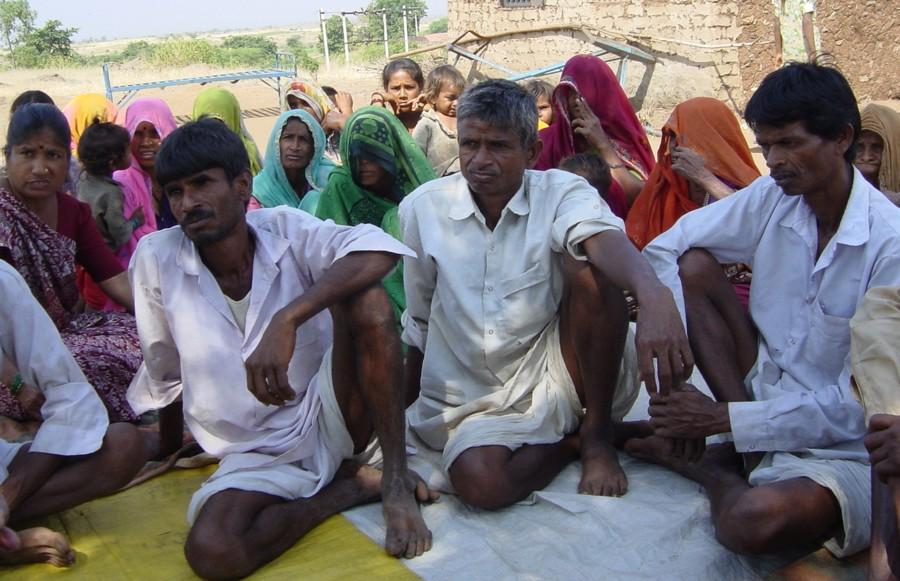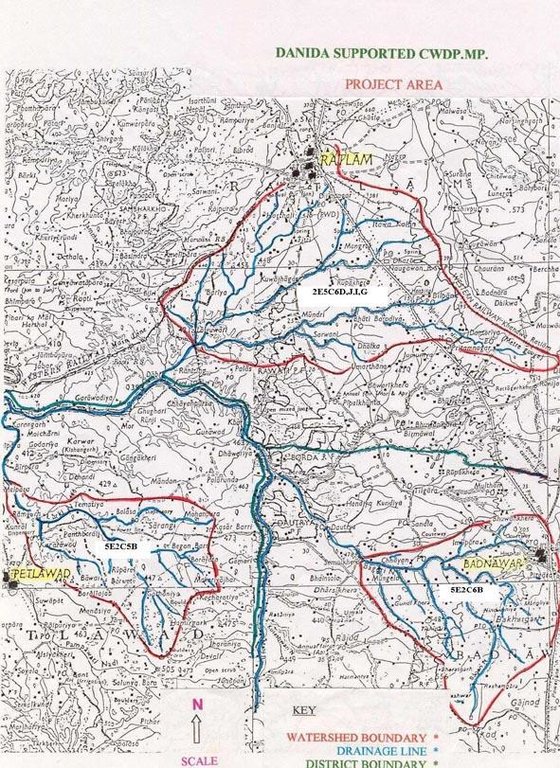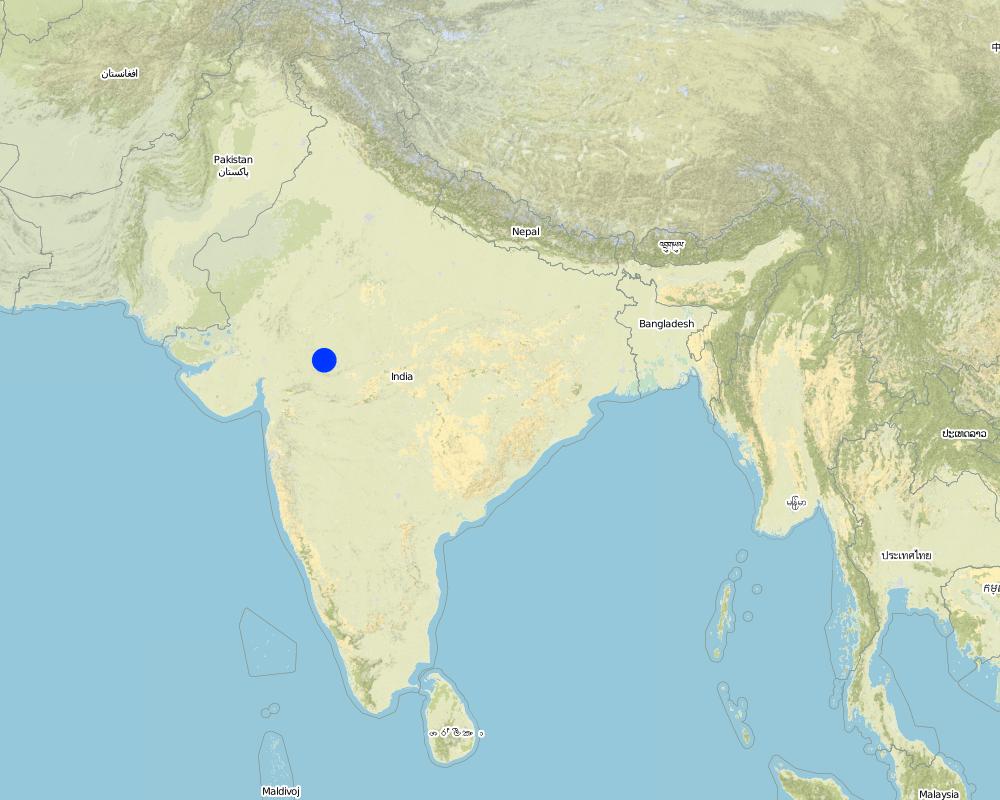Comprehensive watershed development [印度]
- 创建:
- 更新:
- 编制者: David Gandhi
- 编辑者: –
- 审查者: Fabian Ottiger
approaches_2374 - 印度
查看章节
全部展开 全部收起1. 一般信息
1.2 参与方法评估和文件编制的资源人员和机构的联系方式
SLM专业人员:
SLM专业人员:
SLM专业人员:
SLM专业人员:
Desai Nilesh
SAMPARK, Raipuria, Tehsil- Petlawad, Distt. Jhabua (MP)
印度
SLM专业人员:
SLM专业人员:
SLM专业人员:
Bhattacharya Tapan
Lok Biradari Trust, Indore (MP)
印度
有助于对方法进行记录/评估的机构名称(如相关)
Danida assisted Karnataka Watershed Development Project, Bijapur (Danida assisted Karnataka Watershed Development Project, Bijapur) - 印度有助于对方法进行记录/评估的机构名称(如相关)
Lok Biradari Trust - 印度1.3 关于使用通过WOCAT记录的数据的条件
编制者和关键资源人员接受有关使用通过WOCAT记录数据的条件。:
是
1.4 SLM技术问卷的参考
2. SLM方法的描述
2.1 该方法的简要说明
Participatory approach that includes a package of measures leading to empowerment of communities to implement and sustain watershed development.
2.2 该方法的详细说明
该方法的详细说明:
Aims / objectives: The approach adopted under the Comprehensive Watershed Development Project (CWDP) is intended to ensure sustainability of development interventions. This can only be achieved through creating a sense of 'ownership' amongst users, which means involving the community in planning, implementation and management of the interventions. A further, specific objective is to benefit vulnerable sections of the community.
Methods: Various methods are employed to achieve these goals. There is, first of all, awareness generation within the community through exposure visits outside the area, street theatre and video shows. After this comes the formation and capacity building of village level institutions, in particular the Village Watershed Development Committees (VWDCs). Users' groups are also formed. Micro-planning (under a 'village development plan') using participatory rural appraisal (PRA) follows. There are arrangements to ensure participatory execution of the plan, specifying cost and benefit sharing (on average 75%-90% of the work is paid for in cash under this approach). Another important element is to ensure user rights to resources. This entails negotiation with government for rights to produce from common land. Eventually, after initial implementation, management becomes the task of the users' groups: this includes maintenance, distribution of benefits and conflict resolution. The whole process involves NGOs along with government staff in order to achieve better communication all round. The participants have different roles. Government staff (at various levels) provides technical and financial support, as well as assistance towards gaining user rights over resources. NGOs are particularly important in awareness generation and mobilisation, capacity building of village level institutions, and in the process of negotiation with the Government.
Role of stakeholders: The village committee is central in planning and implementation of the village development plan, and in overseeing users's groups. Users's groups are involved in planning, implementation and then resource management. The village assembly helps to identify beneficiaries and users, and to give overall support to the VWDC. An external international donor, DANIDA of Denmark, supports the Comprehensive Watershed Development Project.
2.3 该方法的照片
2.5 采用该方法的国家/地区/地点
国家:
印度
区域/州/省:
Madhya Pradesh
Map
×2.6 该方法的开始和终止日期
注明开始年份:
1997
终止年份(若不再采用该方法):
2007
2.7 方法的类型
- 基于项目/方案
2.8 该方法的主要目的/目标
The Approach focused mainly on SLM with other activities (1- Capacity building of communities, 2- Production system)
- create a sense of ownership amongst users. - ensure sustainability of technical and social interventions. - benefit more vulnerable sections of the community, including the poor and women. - involve the community in planning, implementation and management interventions
The SLM Approach addressed the following problems: previous lack of consultation/involvement with the community in planning, implementation and management of watershed development interventions
2.9 推动或妨碍实施本办法所适用的技术的条件
社会/文化/宗教规范和价值观
- 阻碍
Lack of awareness and mobilisationon improvement of production systems.
Treatment through the SLM Approach: Intensive programme for awareness generation and mobilisation of community
财务资源和服务的可用性/可得性
- 阻碍
Treatment through the SLM Approach:
机构设置
- 阻碍
Lack of effective institutions at village level to take responsibility for the development process.
Treatment through the SLM Approach: Formation & capacity building of VLI (VWDC,UG) with assistance of NGOs.
法律框架(土地使用权、土地和水使用权)
- 阻碍
Uncertainity fover rights to access to resources
Treatment through the SLM Approach: Negotiations facilitated by NGOs
The existing land ownership, land use rights / water rights moderately hindered the approach implementation While treatment of privately owned land did not face a problem, encroachment on Govt. land was an obstacle which discouraged land users from implementing SWC on these lands. Furthermore it was not possible to obtain users rights on lands under the Forest Department, which resulted in their exclusion from SWC in most cases. The NGOs involved however acted as intermediaries in negotiations.
了解SLM,获得技术支持
- 阻碍
High cost water harvesting measures.
Treatment through the SLM Approach: Demonstration of low cost alternatives such as the doh (sunken structure in dry riverbed to increase infiltration of runoff, which replenishes wells for irrigation: see 'related technology').
3. 相关利益相关者的参与和角色
3.1 该方法涉及的利益相关者及其职责
- 当地土地使用者/当地社区
Specific ethnic groups: While the main group were Bhil tribal, other groups included Gujars, Patidars etc.
Due to social factors, traditionally decision making largely done by men. However, the project has worked towards involving women in all aspects of the project. Participation of women in decision making bodies such as village committee is restricted . Participation of women is good in implementation, self-help groups etc. The project is active in neediest & most degraded villages which are fairly homogenous in nature. Furtherore efforts are made to identify and benefit poorest households.
- NGO
- 地方政府
Village Watershed Development Committee, Users Group.
- 国家政府(规划者、决策者)
Govt. of India/ Govt. of Madhya Pradesh, Department of Agriculture.
- 国际组织
Danida
如果涉及多个利益相关者,请注明领导机构:
The broad approach was developed by national and international specialists at the time of project appraisal. The detailed pedagogy was developed by the project in consultation with NGO partners and consultants.
3.2 当地土地使用者/当地社区参与该方法的不同阶段
| 当地土地使用者/当地社区的参与 | 指定参与人员并描述活动 | |
|---|---|---|
| 启动/动机 | 互动 | Mainly:public meetings; partly: awareness generation; Community meeting for discussion. Street plays, exposure visits for awareness generation. |
| 计划 | 互动 | Mainly: rapid/participatory rural appraisal; partly: group meeting; Preparation of village plan. Discussion on village plan. Negotiation, Decision making. |
| 实施 | 互动 | responsibility for minor steps; Landusers provide labour, partly subsidized by project. VWDC members involved in supervision & payments. |
| 监测/评估 | 互动 | measurements/observations; Water levels, migration rates monitored by community with project staff. Gram sabha (Village assembly) meets every 3-6 months to discuss project activity. VWDC meets monthly to take stock. |
| Research | 被动 | on-farm; studies carried out by project staff. |
3.3 流程图(如可用)
具体说明:
CWDP-MP: Comprehensive Watershed Development Project in Madhya Pradesh PIP: Project Implementation Plan VWDC: Village Watershed Development Committee
3.4 有关SLM技术选择的决策
具体说明谁有权决定选择要实施的技术:
- 主要是SLM专家,咨询土地使用者之后
解释:
exposure visits' to outside demonstration sites are used as a tool for sensitisation, motivation and awareness raising.
Decisions on the method of implementing the SLM Technology were made by mainly by land users supported by SLM specialists. Discussion with VWDC,UG.
4. 技术支持、能力建设和知识管理
4.1 能力建设/培训
是否为土地使用者/其他利益相关者提供培训?:
是
明确受训人员:
- 土地使用者
- SWC specialists, extensionists/trainers
培训形式:
- 在职
- 课程
培训形式:
- exposure visits
涵盖的主题:
1- Training for VWDC, UG, SHG's to conduct meetings, accounts and book-keeping. 2- Technical trainings. These are provided by government and NGO staff. Training concentrates on participatory approaches and low cost technologies. Capacity building for community groups and land users enables them to participate better in projects and to take ownership of assets.
4.2 咨询服务
土地使用者有权使用咨询服务吗?:
是
指明是否提供了咨询服务:
- 在土地使用者的土地上
说明/注释:
Name of method used for advisory service: Multi Disciplinary Teams; Key elements: Field staff drawn from different Govt. line deptt. and NGO's., Village level workers selected locally, paid by the Project through NGOs., Formation, capacity building of village level institutions and farmers.; 1) Advisory service carried out through: non-governmental agency, projects own extension structure and agents; Extension staff: Govt.+ NGO employees 2) Target groups for extension: land users; Activities: Capacity building of village institutions, demonstration of SWC measures, production
Advisory service is quite adequate to ensure the continuation of land conservation activities; The state policies now emphasise the participatory approach. However, aspects like GO-NGO cooperation need to be instutionalised.
4.3 机构强化(组织发展)
是否通过这种方法建立或加强了机构?:
- 是,非常
具体说明机构的强化或建立程度:
- 本地
具体说明支持类型:
- 财务
- 能力建设/培训
4.4 监测和评估
监测和评估是该方法的一部分吗?:
是
注释:
bio-physical aspects were regular monitored through observations; indicators: general parameters
technical aspects were regular monitored through measurements; indicators: water levels in some wells
socio-cultural aspects were ad hoc monitored through measurements; indicators: migration
economic / production aspects were regular monitored through measurements; indicators: yield
area treated aspects were ad hoc monitored through observations; indicators: hectares treated
no. of land users involved aspects were regular monitored through measurements; indicators: attendance at meetings
There were several changes in the Approach as a result of monitoring and evaluation: Several technological changes have taken place as a result of a review: for example feedback on yield data led to crop variety recommendations. Levels of water in wells confirmed impact of the 'sunken structures' (dohs).
5. 融资和外部物质支持
5.1 该方法中SLM组成部分的年度预算
如果不知道准确的年度预算,请给出一个范围:
- 100,000-1,000,000
注释(例如主要的资助来源/主要捐助者):
Approach costs were met by the following donors: government (national): 5.0%; international (-): 85.0%; local community / land user(s) (labour): 10.0%
5.2 为土地使用者提供财政/物质支援
土地使用者是否获得实施该技术的财政/物质支持?:
是
5.3 对特定投入的补贴(包括劳动力)
- 设备
| 具体说明哪些投入得到了补贴 | 程度如何 | 对补贴做出具体说明 |
|---|---|---|
| 机械 | 充分融资 | |
- 农业
| 具体说明哪些投入得到了补贴 | 程度如何 | 对补贴做出具体说明 |
|---|---|---|
| 种子 | 部分融资 | |
| Seedlings | 部分融资 | |
如果土地使用者的劳动力是一项重要的投入,那么是不是:
- 以现金支付
注释:
As is common in Indian watershed development initiatives, there is a substantial subsidy towards labour involved. under this approach 75-90% of labour input is paid for in terms of cash: the remainder is voluntary contribution
5.4 信用
是否根据SLM活动的方法给予信用值?:
否
6. 影响分析和结论性陈述
6.1 方法的影响
该方法是否帮助土地使用者实施和维护SLM技术?:
- 否
- 是,很少
- 是,中等
- 是,支持力度很大
The participatory approach has been fairly successful in demonstrating SWC technologies such as Silvi Pasture, Sunken Structures which have been adopted/maintained by the land users.
该方法是否改善了阻碍SLM技术实施的土地使用权/用户权问题?:
- 否
- 是,很少
- 是,中等
- 是,支持力度很大
By using the approach, the project was able to win the confidence of most land users.
Did other land users / projects adopt the Approach?
- 否
- 是,很少
- 是,中等
- 是,支持力度很大
The pilot project which has tested the approach over past 3-4 years is implemented by the Department of Agriculture. The State Department of Agriculture has now expanded the approach to its other projects eg. NWDPRA.
6.3 方法活动的可持续性
土地使用者能否维持通过该方法实施的措施(无外部支持的情况下)?:
- 不确定
若否或不确定,请具体说明并予以注释:
1- NGO's will contrinue to visit villages where project has completed bio-physical activities for a period of 2-3 years with a view to provide support and further training to VLI's & communities. Hence it is pre-mature to comment at this stage.
6.4 该方法的长处/优点
| 土地使用者眼中的长处/优势/机会 |
|---|
| Awareness about SWC increased through street plays, exposure visits. Use of drama preferred to verbal communication. (How to sustain/ enhance this strength: Continue, and include visits to successful income generating projects.) |
| Participatory planning has led to better understanding of resources and possibilities (How to sustain/ enhance this strength: The entire village plan should be implemented in defined stages to allow impact to be noted/felt.) |
| Cost-sharing increases feeling of ownership. (How to sustain/ enhance this strength: Community contribution should be deposited in the village fund to enable further activities after project moves out.) |
| Due to village institutions, there is greater decentralisation of ressponsibility and more people are actively involved. |
| As a result of village fund, interest component remains within the village. |
| Increased transparency as a result of GO-NGO cooperation. (How to sustain/ enhance this strength: Less rigidity in roles of GO/NGO staff.) |
| 编制者或其他关键资源人员认为的长处/优势/机会 |
|---|
| Marginalised groups have been identified and given a 'say' (How to sustain/ enhance this strength: NGOs should continue to advise/guide/monitor activities) |
| Systematic approach to strengthen community participation (How to sustain/ enhance this strength: Detailed 'process documentation' to be continued.) |
| Leadership developed at village level. (How to sustain/ enhance this strength: NGO's continue to advise/guide/monitor activities in the village.) |
| Land users develop a strong sense of ownership of the assets created. (in terms of cost-sharing, a local contribution of up to 25% is high in Indian contexts) (How to sustain/ enhance this strength: There needs to be continued support for 2-3 years after phasing out of bio-physical watershed development activities; also important to build up village funds through a 'community contribution' charge deducted from wages.) |
| Government system can be strengthened by co-operation with NGOs in watershed management projects (How to sustain/ enhance this strength: Continue dialogue between partners at various levels..) |
6.5 该方法的弱点/缺点以及克服它们的方法
| 土地使用者认为的弱点/缺点/风险 | 如何克服它们? |
|---|---|
| Formation of User group creates conflict with surrounding villages. | |
| Segregation of responsibilities of GO-NGO staff viz. NGO role restricted to community organisation while GO staff deal with technical asspects. | Better integrated teamwork should be the goal. |
| A 'community contribution' charge is currently deducted equally from all villagers by the project from wages paid | Contribution to be deposited in village fund., Should be a greater voluntary contribution from the richer farmers. |
| Participation in various meetings at village level is cumbersome for women, resulting in increased pressure from male family members and loss of wages. | |
| Project duration for planning and implementation too short | Increase the timespan to 3 years or more. |
| Women not adequately involved in exposure visits. | Correct this imbalance/arrange separate visits for women. |
| Exploitation by middlemen when small farmers market produce not addressed by the project. | Group marketing of produce. |
| 编制者或其他关键资源人员认为的弱点/缺点/风险 | 如何克服它们? |
|---|---|
| Because of low literacy levels NGO support to village level institutions is required for more than just short-term | Adult literacy classes of sufficient duration are needed. |
| PRA brings out many social factors that are beyond the scope of the project to influence eg the feudal system | NGOs need to have broadbased activity platforms that can address these issues as they arise. |
| Shortage of female staff restricts contact with women land users. | Gender sensitization, training for project staff intensified. |
7. 参考和链接
7.1 方法/信息来源
- 实地考察、实地调查
- 与土地使用者的访谈
7.2 参考可用出版物
标题、作者、年份、ISBN:
'Participatory approaches in watershed management- successful experinces' David Gandhi 2002
可以从哪里获得?成本如何?
Indian Association of Soil Conservation, Central Soil & Water Conservation Research & Training Insti
链接和模块
全部展开 全部收起链接
无链接
模块
无模块







